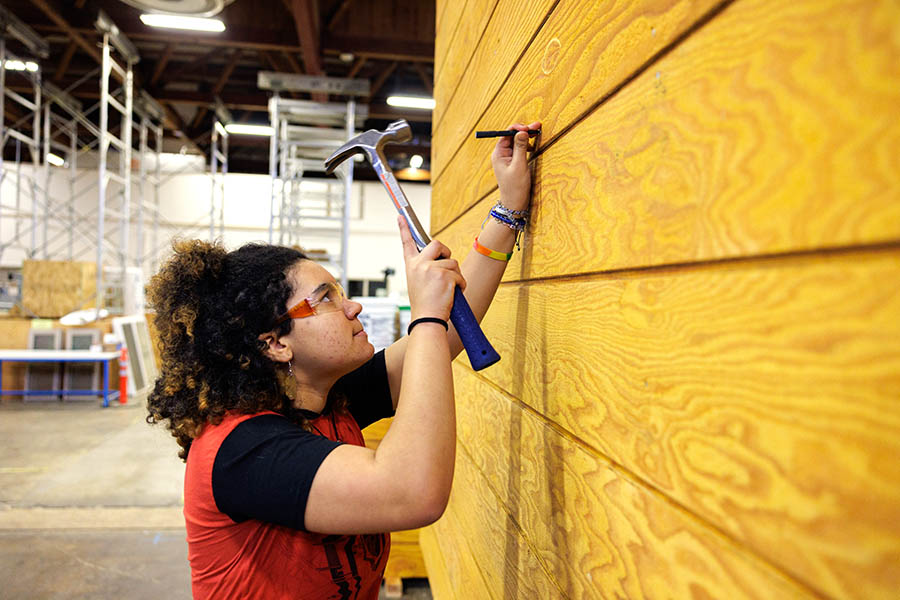Career and Technical Education construction programs immerse Oregon high school students in the construction trades. What challenges await this next generation of builders?
As a young woman of color studying and working in the construction industry, Victoria Murguia developed thick skin early on. Over the years, she endured plenty of comments and pushback from male colleagues both in the classroom and on the job site. “But I don’t let it get to me. At this point, I’m not taking shit from anyone,” she says.

Murguia’s confidence is well deserved. She just earned her bachelor’s degree in construction engineering management, with a minor in business, from Oregon State University. At the same time, she works full-time as a project engineer for Pence Contractors, helping build a new elementary school in Cornelius. But her career actually launched way back in 2017, the year she graduated from the Viking House, Forest Grove High School’s Career and Technical Education construction program.
Viking House students have built one high-end, single-level home every year for the last 49 years. The program also fledged a community of Career and Technical Education alumni who thrive in the construction trades and help each other up.
“I wore my Viking House hoodie to a seminar given by Pence Construction my freshman year of college,” Murguia recalls. “Someone from the company, who also graduated from the program, saw it and asked if I was looking for an internship.”
One interview later and Murguia has been at Pence ever since. She worked all through college on local projects she cares deeply about.
“The whole reason I got into construction was to give back to the community I was raised in,” Murguia says. She describes getting to work on the new Cornelius Elementary School, part of the Forest Grove School District, as a “full-circle moment.”

Oregon’s Career and Technical Education programs — or CTE — give students real-world, hands-on experience in a variety of fields from agriculture to health sciences to industrial and engineering systems. In the 2023-2024 school year, 85 high schools offered CTE in architecture and construction, according to the state’s Department of Education.
Kids leave these programs work-ready. “Last year we had a few students graduate on Friday and start working their new jobs on Monday,” says Dr. Andy Dey, superintendent of Eugene School District 4J and architect of the district’s Future Build CTE program. [Dey is separating from the district June 30 following allegations of bullying and retaliation.] Many go back to school or become apprentices to train in specialized fields like plumbing or electrical.
That’s good news for a sector in desperate need of workers. Right now there are 6,400 vacant construction positions to fill, according to Oregon’s Employment Department’s most recent job-vacancy survey. It’s a pernicious trend. “Today’s numbers are noticeably lower than they were during the pandemic but a bit higher than they were pre-pandemic,” explains Josh Lehner, senior economist for the state.
The graying of the industry’s current workforce compounds the problem. “More than one in five construction workers are 55 or older,” writes Anirban Basu, chief economist for Associated Builders and Contractors in a press release. “[This means] that retirement will continue to contract the industry’s workforce. These are the most experienced workers, and their departures are especially concerning.”
At the same time, a record number of young Oregonians, ages 19 to 24, are currently working construction, according to Lehner, writing on X (formerly known as Twitter). This group is poised to pick up where their parents — and grandparents — left off.
Daniel Contreras is one of those freshly minted workers. The 19-year-old Hermiston High School graduate completed the Columbia Basin Student Homebuilder Program in 2023. After graduation he had two construction companies vying for his skilled labor. Today he puts up pole barns as a crew member for Cleary Building Corp.
“I like working with my hands. It makes me feel good about what I’m doing. And I’m very happy with my pay,” he says. Contreras credits his time working on the Columbia Basin Student Homebuilder Program with helping him find and hone his passion. Available to students in Hermiston, Umatilla and Stanfield, the CTE program, like Forest Grove’s Viking House, produces one student-built home every year. “I trimmed out the door and window frames for that project house. It really gave me a sense of pride and showed me what quality work looks like.”
While Contreras enjoys the job he’s doing now, he has plans to go back for more training. “I’m saving as much money as I can now so I can pursue the electrical trades.” He’s choosing school over an apprenticeship because, as he puts it, “it’s faster. School would take one and a half years while an apprenticeship is four.”

Curt Berger has run the Columbia Basin Student Homebuilder Program since its start 10 years ago. A former tennis and wrestling coach and Computer-Aided Design instructor, Berger earned his contractor’s license in preparation for the task. Starting with a “$400,000 grant from the state, we’ve built and sold nine of these great homes,” he says. Proceeds from the previous year’s sale go into funding next year’s house.
And the homes fetch a premium. They are high-end, with unexpected details like timber-beam ceilings.
“These houses would be considered custom homes if they were on bigger lots,” says Berger, adding that the last home sold for $237 per square foot. “It would have gone for $650 per square foot if it was in the Tri-Cities area.”

The program also gives students real insight on what it takes to bring a project in — and if the construction trades are in fact a good fit. “They have to be consistent. It’s not like you turn in a term paper and you’re done,” Berger insists. “Rain, snow, mud or yuck, they have to be on the site. You can’t be a yo-yo.”
Over the years, Columbia Basin Student Homebuilder Program students have actually gotten better at the job.
“We used to pour the foundation and do the framing for these projects,” says Brent Pitney, owner of Knerr Construction and board member of Northeast Oregon Home Builders Association (NEOHBA is a longstanding partner with the program). “Now the students do the framing themselves. This year they called on us to unroll the roof tresses, and the kids were up there sheeting with us.”
Pitney has nothing but praise for the CTE program, particularly when it comes to hiring the next generation of workers. “Finding employees is a constant struggle,” he says, “particularly with current workers getting long in the tooth. This program shows kids that construction is a great career.” Pitney does acknowledge that outside forces, like high interest rates, make building any new project that much harder to tackle.
One element builders and learners in Eastern Oregon don’t have to worry about is land availability. The Columbia Basin Student Homebuilder Program presently owns enough land to keep the program running for more than 10 years. “And there’s plenty more available after that,” says Berger.
The same cannot be said for Forest Grove’s Viking House. In fact, the program is in jeopardy — but not due to lack of interest.

The longstanding program is very popular — so popular that 2020 saw 52 applicants competing for 16 available positions. “We had to institute a time/skills test to make admission fair,” reports program instructor Chris Higginbotham.
And the homes they produce are as desirable as the chance to work on them. All Viking Houses are single-story and designed with discerning buyers in mind.
“Everything is above and beyond code,” says Higginbotham. That means using advanced-framed exterior walls, duct work hidden in interior, conditioned spaces and high-efficiency heat pumps to maximize energy efficiency.
Viking Houses are known for their craftsmanship, detailed finishes and upgrades. “Nothing is builder basic,” Higginbotham boasts. The homes even swept the awards categories in three different home shows. “Stone Bridge Homes NW invited us to participate. It was a lot of pressure to compete with professionals, but the students did a great job.”
So why is a wildly popular CTE program that delivers a premium product year after year in trouble? “The biggest challenge is finding available land to build on. The district has been trying for years but they haven’t been able to purchase any lots from local developers,” says Higginbotham.

The problem appeared to have been solved when a Forest Grove School District-owned plot of land was deemed too small to build an elementary school on. Unfortunately, the land was bought with bond money, so use rules mean the plot cannot transfer to the Viking House.
“We’re now down to two lots, one for this year and one for our 50th anniversary next year. I don’t know what will happen after that,” Higginbotham laments.
School officials seem unsure as well. “The district is actively searching for future properties to continue the Viking House program,” wrote director of finance and operations Ilean Clute in an emailed statement. “The district has hired a local real estate agent who is actively contacting local developers and landowners about the possibility of purchasing or dividing lots.”
The recent passage of Senate Bill 1537 may help those developers and landowners feel better about parting with some of their stash. While the new law is designed to boost the production of affordable and middle-income housing stock — which the Viking House is definitely not — provisions for Urban Growth Boundary land swaps may make a sale to a school district pencil out … eventually.
“It’s a voluntary process. You would have to find the right landowner and the right city. And even then, it’s going to take time,” says Jodi Hack, CEO of the Oregon Home Builders Association.
While the future of Viking House remains uncertain, Senate Bill 1537, coupled with Senate Bill 1530 and House Bill 4134, will pump a total of $376 million into boosting housing production, funding infrastructure and providing support to renters. All good news for a state that is short an estimated 140,000 homes right now and needs more than 440,000 new homes in the next two decades to keep up with future demand, according to the Oregon Capital Chronicle.
That is also good news for the job prospects of newly graduated construction professionals currently in CTE programs. Students in Eugene School District 4J’s new Future Build CTE program are already getting started building much-needed affordable housing. This program is similar to Viking House and the Columbia Basin Student Homebuilder Program in that high school students work alongside professionals to create a single-family home.
But once completed, this home will be sold to a local nonprofit organization that then transfers ownership to a family transitioning out of homelessness. “It adds an extra level of meaning to the program,” Dey says. “These students know what it means to get involved with something that matters. They are addressing a real problem in the community.”
The two-year-old program has already delivered one three-bedroom, 1,800-square-foot home and students are working on the second project. Approximately 25 students have been through the program, and between 75 and 100 are signed up for the 2024/2025 school year. With a population of 53,000 high school students, Dey sees room for more growth but wants to approach it with sustainability in mind. “I don’t want to bite off more than we can chew.”
Part of that sustainability requires finding more industry partners, particularly one willing to take on the developer role. “Right now we’re the developer,” Dey says. He would prefer district teachers focus on skills they know best like “pedagogy, developing curricula and knowing how to work with adolescents. We can take care of the ‘school things.’”
Dey suggests this partnership model to other school districts looking to start similar programs. “Oregon has a lot of small districts, and the standup costs to a program like Future Build are prohibitive,” he says. “Education service districts, workforce-development boards, and professional entities would love to come together and be in schools. You have to find the right fit.”
These CTE construction programs prove that if schools build it, students will come. It’s a big change from shining the brightest light on four years of college as the best option after graduation. The perceptions about the construction industry, of course, have changed as well.
“There used to be a lot of concern about the stability of construction jobs,” says Hack of Oregon Home Builders Association. “Now there is so much good, respectable, well-paying work out there. These are great jobs.”

And industry culture has changed as well. Across the U.S., about 1.3 million women worked in the construction industry in 2022, embodying almost 11% of the total workforce. This represents a 53% increase over the last decade. Oregon’s numbers are higher, with 13.5% of the total workforce being women, according to Labor Finders.
Murguia, the 2017 Viking House graduate, experienced the change firsthand. “I used to be the only women in a meeting or at the site. Now I’m not alone.” Pence, her longtime employer, has made hiring women a priority, noting on its website that its workforce is 20% women, nearly twice the industry average. “Pence always has my back,” she says.
Of course, construction is not for everybody. But these programs let kids explore and maybe find their true passion.
“I really enjoy this,” says Contreras. And to other students thinking about trying a CTE construction program, he says, “Try it. We need people. We build the world.”
Click here to subscribe to Oregon Business.





